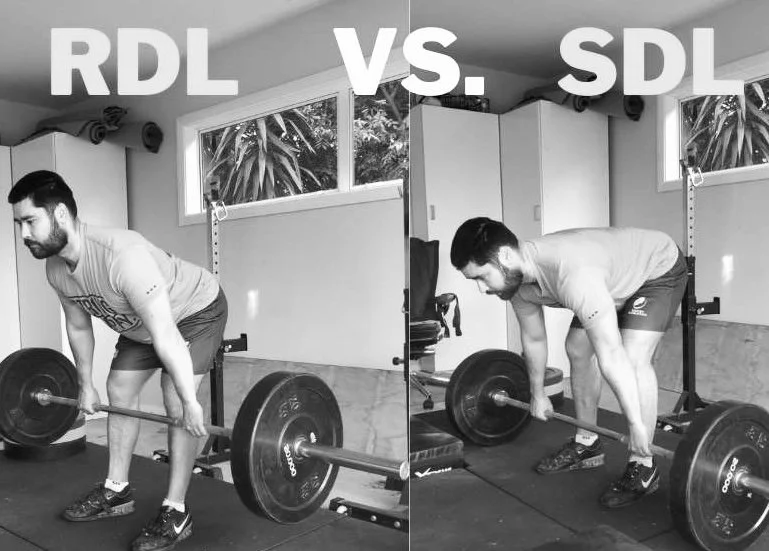Romanian Deadlift & Stiff-Leg Deadlift
The Romanian deadlift (RDL) and the stiff-leg deadlift are both versions of the classic deadlift. Both lifts can increase your strength and target different deadlift sticking points.
The stiff leg deadlift starts from the floor and is initiated from a dead stop position.
The Romanian deadlift starts from the hip and is only lowered to just below the knee to maximize hamstring development.
Both movements are used to target lower back strength, teach and reinforce a firm hip hinge position, and increase loading to the glutes and hamstrings.
Range of Motion
The major difference between these variations is their range of motion. Romanian deadlifts are designed to have the bar stop around shin level — the plates aren’t supposed to touch the ground in between reps. Stiff-leg deadlifts, on the other hand, come to a dead stop on the platform between each rep. That means that RDLs have a shorter range of motion than stiff-leg deadlifts.
Loading
A general guideline is that you should be able to pull both of these deadlift variations between 50-70% of your back squat max.
Specificity to Competition Lifts
For weightlifters and competitive pullers (snatches, cleans, and deadlifts), there is an optimal amount of knee flexion (bend) during the first pulling of the ground. As a lifter transitions throughout the snatch or clean, you need both tension and proper timing to scoop yourself back under the barbell. This often happens after the bar passes your knees, as you approach the second phase or drive/power phase of the Olympic lift
The Romanian deadlift requires you to start in the bent-knee position, allowing you to develop the necessary timing and tension development you need in Olympic lifts. Meanwhile, the stiff-leg deadlift has a lifter start in a fully extended position, only slightly bending as flexibility and hamstring tension mounts. This makes the stiff-leg deadlift slightly less specific to the formal Olympic lifts and even deadlifts.
Hip Hinge Training
Regardless of your knee position, you’ll be using a hip hinge to initiate and drive both the RDL and stiff-leg deadlift. Because of that, both of these deadlift variations will help you develop a strong hip hinge movement pattern. If you’re looking to practice your hinge and want to add lower body pulling volume to your routine, either of these lifts can suit your needs.
Romanian Deadlift Vs. Stiff-Leg Deadlift Technique
The primary difference between these two hip hinge lifts. While the basic shape of the lifts is similar, your degree of knee flexion will be much different. Therefore, the angles you’re lifting from will change, as will the muscles emphasized by the lifts.
Knee Bend (Flexion)
While there is a very small degree of difference between these two movements regarding knee flexion (bending), the impacts are still significant. When performing the Romanian deadlift, a lifter fixes their knees in the bent position. If you’re used to snatching, cleaning, or deadlifting, this knee flexion is often at the exact angle used during the first and second pulls of the snatch and clean or during the deadlift. This generally allows for increased range of motion and less dependency on lower back strength and hamstring flexibility.
On the other hand, the stiff-leg deadlift has you assume a fully extended position at the start. Your knees will be only slightly bent at the point at which hamstring and lower back tension are at maximum. potentially making the stiff leg deadlift a more hamstring and lower back intensive lift which can be programmed for hypertrophy specific purposes or postural control.
Muscles Engaged/Cueing
The RDL allows similar flexion angles to your regular deadlift. This places a greater emphasis on the hips, glutes, and hamstrings as a whole. Because of the smaller degree of knee flexion, the stiff-leg deadlift places greater emphasis on lower back strength and hamstring flexibility and strength. This makes it a potentially greater movement for isolation to those muscle groups.
How to Do the Romanian Deadlift
Set up just like you do for your conventional deadlift. Approach the bar so that your feet are about hip-width apart, with the bar above your midfoot. Stiffen your torso and hinge at the hips with a soft bend in your knees. Grab the bar with a flat back and your hands slightly wider than shoulder-width apart.
With your core braced, maintain a rigid torso, engage your lats, and press through your feet. Drag the bar along your shins, lifting with your hips and hamstrings. When the bar passes your knees, let your glutes, upper back, and core contract to bring your body back to standing.
Instead of returning the bar to the ground between repetitions, let the bar slowly lower close to your body. When the bar reaches shin height, bring the movement to a halt and return to standing. Rinse and repeat.
Benefits of the Romanian Deadlift
Allows you to deadlift a fairly heavy amount of weight while emphasizing your glutes, hips, and hamstrings.
Increases focus on sports-specific components of the deadlift, translating into stronger competition lifts for powerlifters and weightlifters.
How to Do the Stiff-Leg Deadlift
Set your body up as you would for a conventional or even a Romanian deadlift. Place your feet about hip-width distance, with your shoelaces under the bar.
When you hinge at your hips, keep your knees as straight as possible. A little bit of softness is okay — you don’t want your knees locked out — but the goal is to place emphasis on hamstring flexibility and a strong hip hinge to help you reach the bar.
Grasp the bar in the same way you do for a conventional deadlift or an RDL. Pay extra attention to keeping your torso rigid, since your hinge will likely be much more exaggerated than it is in a regular deadlift. Brace your core, engage your lats, and drag the bar along your shins to standing. Engage your glutes and low back to help you lock the bar out.
Reverse the movement, slowly lowering the bar all the way back to the ground. Keep your legs stiff throughout, resisting the temptation to bend your knees more generously. Once the bar settles on the ground, re-establish tension and repeat
Benefits of the Stiff-Leg Deadlift
This version can help your conventional deadlift, especially when your low back is failing at lockout.
Stiff-leg deadlifts can reinforce a perfect hip hinge and flexible hamstrings. You’ll have no choice but to lift from your hips while keeping your knees relatively straight.
The Romanian Deadlift Vs. Stiff-Leg Deadlift — When To Use Each
Even though the RDL and stiff-leg deadlift are both effective deadlift variations, there are different times and places for both of them in your program. Depending on your experience level and goals, you’ll often have to evaluate which lift is most effective for you during a given training cycle.
For Strength
Because you can generally move more weight with the Romanian deadlift, this variation might be more efficient for you when building maximal strength. But that doesn’t mean the stiff-leg deadlift has no place in a program geared toward strength.
Since the stiff-leg version puts more emphasis on your lower back, think about whether your low back is a weak point in your deadlift. If it is, you might choose to integrate the stiff-leg deadlift to help you eliminate that sticking point and build maximum strength.
For Muscle Growth
If you want to grow your hamstrings and glutes, try programming more RDLs into your program.
If you’re looking to increase muscle mass in your low back, however, stiff-leg deadlifts might be a stronger option for you. Stiff-leg deadlifts also place a strong emphasis on your hamstrings, but you’ll be moving less weight, so they might be less effective for hypertrophy there.
For Sports Performance
Romanian deadlifts have a similar knee position to conventional deadlifts and to the initial pulls in snatches and cleans. Because of this, there is a lot of direct sports-performance crossover from the RDL for powerlifters and weightlifters.
However, if you know you need more flexible hamstrings for your sport — that can include powerlifting and weightlifting — the stiff-leg deadlift might be a good option for you. Similarly, if you need to build a stronger, more resilient lower back for Strongman events, the stiff-leg deadlift will surely come in handy.
For Beginners
If you’re a beginner in strength sports, it’s likely that you’re still developing proper conventional deadlift technique. To reinforce regular deadlift positioning and technique, beginners should probably stick to Romanian deadlifts. On top of that, many beginners just don’t have the hamstring flexibility or technical finesse needed to pull off a successful stiff-leg deadlift.
Summary
Both the Romanian and stiff-leg deadlift are solid choices when you want to develop more strength in your hamstrings, hips, glutes, and lower back. But the lifts call for different degrees of knee flexion, and RDLs don’t even touch the ground between reps. Because of these different ranges of motion, each lift excels at improving different parts of your deadlift and overall strength game. Paying attention to these differences can help you refine your training and help you get that much closer to your lifting goals.




